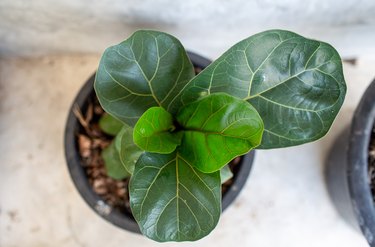
In its natural habitat of subtropical and tropical Asia and Australia, a ficus tree (Ficus benjamina) can grow up to 60 feet tall. Hardy in U.S. Department of Agriculture plant hardiness zones 10b through 11, this tropical evergreen tree is grown as a houseplant, where it seldom exceeds 8 feet tall. Ficus, also known as weeping fig and Benjamin tree, is fussy about its environment, with leaf drop a common issue. Determining why your ficus is dropping its leaves is the first step to keeping your houseplant healthy.
Tip
Ficus drops its leaves due to improper watering, fertilizing, lighting and temperature changes.
Video of the Day
Watering Your Ficus
The ficus grows best in moist, well drained soil. Yellowing leaves that fall from the plant indicate that you are not providing your ficus with enough water. Green leaves falling from the ficus generally means that your plant has been over-watered.
Video of the Day
Water your ficus when the top 2 inches of soil is dry. Add water until it drains from the bottom of the pot. Do not water again until the top 2 inches of soil is dry. If there is water in the drip pan for more than a day, empty it; the excess water will wick up into the potting mix and make it too wet, which can lead to dropped leaves and in severe cases, root rot.
Mist your ficus regularly to raise the humidity around the plant. A cool steam vaporizer or placing the pot on top of a pebble and water-fill tray will also add much-needed moisture to the air.
Fertilizing a Ficus Tree
Ficus grown as houseplants should be fertilized monthly with a balanced 20-20-20 liquid fertilizer. Dilute the fertilizer according to the package directions or, if the plant is stressed, to one-half the recommended strength. Water the plant, let it drain, then pour the fertilizer solution into the pot until it drips from the bottom. Water again after fertilizing to protect the tender roots.
Your ficus may drop its leaves if fertilized too often or if there is a salt build up in the potting mix. If the plant shows signs of stress, put the plant and pot in the sink and run a slow stream of room temperature water through the potting mix for up to 15 minutes. This helps flush out excess fertilizer salts. Allow the water to completely drain from the pot before putting it back in its usual location.
Stressing Your Ficus
A change in temperature, due to air conditioning or heating, or even a change of season, may stress your ficus enough that it will lose healthy green leaves. Ideally, daytime temperatures should be between 75 and 85 degrees Fahrenheit and night temperatures between 65 and 75 degrees.
The ficus does not react well to drafts. This includes drafts from an open door, but also air from fans and air conditioning vents. Drafts will cause healthy green leaves and new emerging leaves to drop from your ficus tree. If possible, remove the source of the draft before moving the tree, because changing your tree's location will also result in leaf drop.
After a leaf drop due to stress, the plant should acclimate to the temperature changes over a few weeks. You will know that the plant is going to recover when new leaves begin to appear.
Lighting Changes and Leaf Drop
The ficus tree needs bright filtered or indirect light, such as from a south or west window covered with sheer curtains. If your ficus is not getting enough light, mature green and even new leaves will drop from the tree. However, be careful about giving your ficus too much light as well; this will burn the leaves.
When you move your ficus from one location to another, such as from one window to another, or even across the room, it will respond by dropping a good percentage of its leaves. This is a normal reaction and the tree should recover once it acclimates. This often occurs right after you purchase the plant and move it into your home. Simply clean up the fallen leaves and water regularly; your plant should recover in a few weeks.